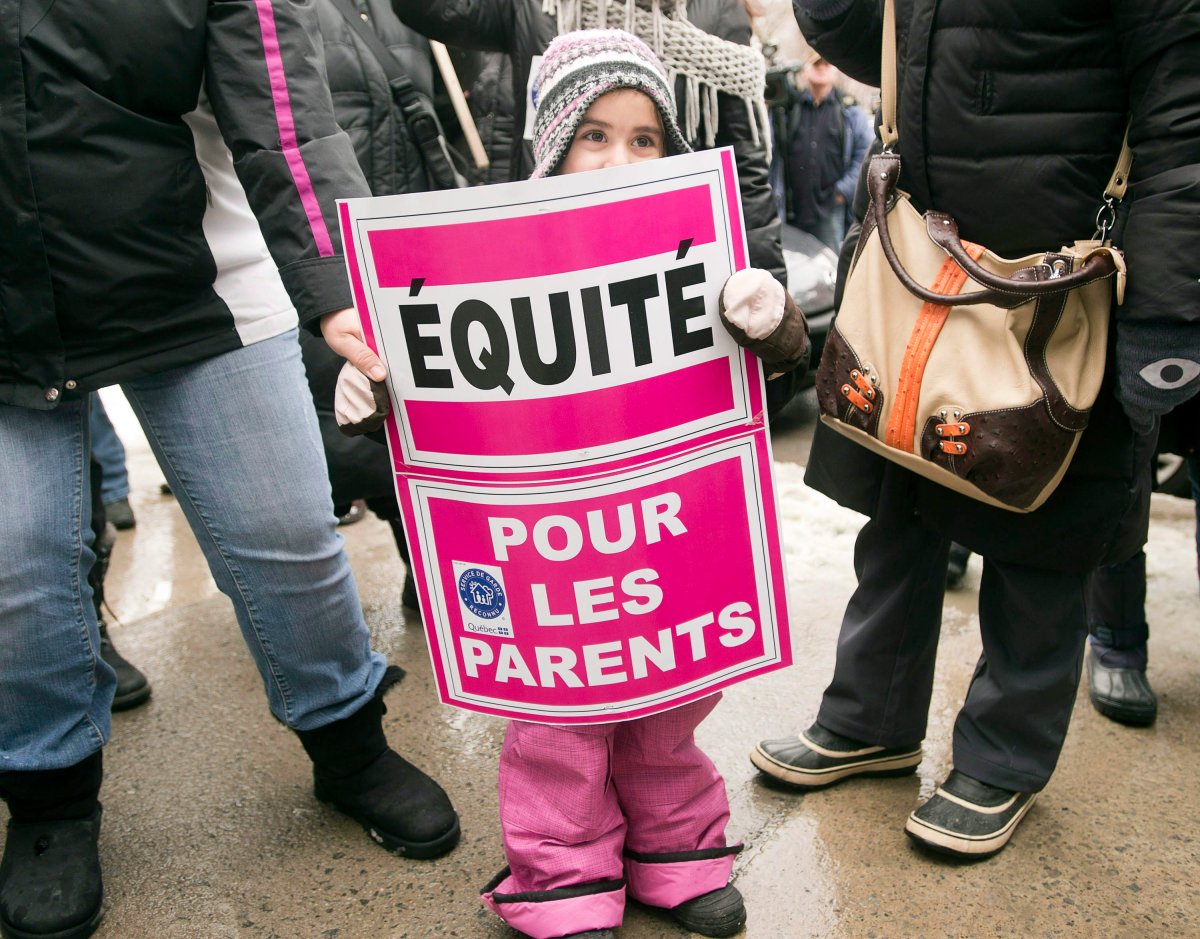Trevor Holness is stuck.

He and his wife Linda don’t make enough to pay to put two-year-old Linden in daycare five days a week; just two days sets them back a cool $550. But staying home with Linden means Holness can’t take on enough film industry gigs to make more.
“You’re caught in the middle of having to limit the number of days you can work so you can look after your child, [but] you’re giving up your potential earning ability, and even your job prospects. … It’s really like being on a treadmill.”
Holness wishes daycare “were looked at as something that was more of an investment, just like our education system.
“It really seems like it’s not a priority.”
Paulette moved from British Columbia to Manitoba for work, then found herself shut out of the job market in both provinces when she couldn’t get subsidized daycare for her two children.
When Carmen wanted a second child, she did the math and realized she’d need a second mortgage to cover child care — or be forced to stop working altogether.
Angela has college and university degrees but finds herself squeezed between student loan repayments and child care costs for two kids, with nothing left over.
Becky, a pilot and manager at a mid-sized B.C. company, makes a good living until you calculate the cost of care for her two little kids: Her job’s odd hours mean they need a nanny, but the $2,000 that costs them a month (more, if she works overtime) isn’t much more than the local going rate of $900 per child, per month for daycare spaces.
“With adequately subsidized childcare, the whole dynamic would shift,” she said.
“A monetary incentive to actually go to work would substantially decrease welfare and EI payouts, but only if a parent could actually take home more money, even on a minimum wage job, than what they would get from government assistance.”
All of these people reached out to Global News in response to our series on Canada’s persistent instability trap.
Across Canada and across the income spectrum, these families feel kneecapped by the cost of child care and lack of spaces. It’s keeping parents out of the workforce, in poverty or preventing them from saving money and planning for the future.
Read the series
- Canadians want to work. Why have so many stopped looking?
- Instability trap: When you’re income rich, but asset-poor
- Chequed out: Inside the payday loan cycle
- Feb. 23: Retirement lost
- Your Stories
Government response: What the feds had to say about Canadians’ labour instability trap
This hurts not only individual parents and children but the economy as a whole, research shows. It can push parents out of the workforce and onto social assistance or force them to make unstable, potentially less safe arrangements for their kids’ care while they’re at work. It can hobble families’ abilities to pay off debts or save for the future.
While the OECD has been calling for years on Canada to boost its investment in child care, a 2013 report found Canada spends below 0.3% of its GDP on child care — well below France, the UK and Scandinavian countries, which spend upwards of 1%.
A 2012 paper from the County of Wellington Childcare Services argues that “strategies without child care provisions and supports for improvements to family income have had little impact on reducing child poverty.”
After increasing for decades, Canadian women’s participation in the labour market has plateaued over the past decade, Global News analysis found. Last year was actually its lowest point since 2006.
This is especially problematic as fewer men are in the workforce than ever before, Global News found. And, ideally, women’s workforce participation should continue to rise to make up that slack, said Mike Moffatt, senior economist with the Mowat Centre and the Ivey School of Business.
But analysts say the federal government’s policies, especially its income-splitting program, will cost a lot of money and overwhelmingly benefit wealthy, single-income households. Japan is one country considering reversing its equivalent of Canada’s income-splitting policy in the hopes of boosting the economy and women’s involvement in the workforce.
“One of the big concerns about income splitting is it does just he opposite: It encourages one-income families,” Moffatt said.
“The biggest barrier to female labour participation rates is affordability of childcare.”
The $160 a month the federal government now gives families with young children will barely cover a few days of daycare in most parts of the country, Moffatt noted.
U.S. President Barack Obama emphasized child care’s economic importance in his State of the Union speech last month.
“It’s time we stopped treating childcare as a side issue, or a women’s issue, and as the economic priority that it is.”
Many have hailed Quebec’s universal $7.30-a-day childcare program a success, crediting it with boosting not only labour force participation but the province’s economy itself. A paper from the University of Sherbrooke’s Research Chair in Taxation and Public Finance estimated the childcare policy provided a 1.7% boost to Quebec’s GDP in 2008.
“The presence of affordable and available childcare stimulates economic growth by increasing employment and therefore spending and tax revenues,” reads a paper from the Canadian Centre of Policy Alternatives published earlier this month.
At the same time, notes the paper’s co-author Kate McInturff, it saves the government money on social assistance as families get a chance to move out of poverty.
“Having access to affordable childcare really can be the difference between living in poverty or not.”
But Quebec’s program is far from perfect. “It’s really not universal due to lack of spaces,” Moffatt said. “The spaces tend to go to higher income families. …
“There’s a number of models to get you there. But the focus has to be on both affordability and accessibility.”
And other studies have questioned the quality of care provided and its impact on both children’s development and parent-child relationships. While the economic boost is real, the authors of this 2005 paper caution that the need for accessibility and affordability shouldn’t come at a cost of quality.
But “good child care allows mothers to be employed and to have families,” argues a 2003 paper from University of Toronto economists, who also argue it can help children succeed later in life. “Having mothers in the labour force has improved Canadian productivity and ultimately Canadian competitiveness.”
Without government subsidies, McInturff argues, child care spaces are too few, too pricey and don’t pay a living wage to the people caring for children, especially in the unregulated spaces that make up for the shortfall.
“We have to ensure … parents are able to find a place for their kids and they’re not just acting out of desperation, which is what they’re doing now,” she said.
“You have to invest in that.”
Both opposition parties have promised some form of universal child care: NDP leader Tom Mulcair unveiled a plan last fall for Canada-wide $15-a-day child care. Liberal leader Justin Trudeau wouldn’t say whether he’d try to bring back the Liberals’ defunct 2005 universal childcare plan, but said he’s working on something.
The federal Conservative government argues it ‘s a question of choice.
“It’s simple,” Employment Minister Pierre Poilievre‘s spokesperson wrote in an emailed response to Global News questions.
“We know that parents are looking for more choices with childcare and the reality is that we’re the only party that trusts parents with their own money.”
But many parents — dozens of whom sent us their personal stories over the course of our series — find themselves without choices and without money.
Robert and his wife are thirtysomething professionals who just had their first child. As parental-leave pay runs out she’s looking for new a new engineering gig (her previous contract ended the day she gave birth).
“We hope this is not a glimpse of our future in having to make a choice to either raise our child or go to work,” Robert wrote.
Without two incomes “we may lose our home. … We are constantly hearing about our government balancing the books, and we can’t help asking ourselves if it is at our expense that they are able to do this.”
Five years after being sidelined by a car crash, Saskatchewan resident Deb wants “so badly” to get back into the workforce, but she can’t afford even subsidized spaces for her three toddlers.
“How can anyone do that on minimum wage? I see that there is a cruel cycle that limits people incredibly in this province,” she wrote in an email.
“There are nothing but good-news stories around our job numbers and supposed economic growth. That, I think is a lie.
“I do not believe that we are, as a country, growing anything but opposite of the socially aware country we used to be.”
Priscilla’s efforts to give 7-year-old Michael and 3-year-old Tannis a better childhood than her own is becoming her financial undoing.
She could move to a cheaper part of Winnipeg and pay less rent. But she worries about exposing her kids to the rougher North End.
“I don’t think that because I’m a single parent and struggling, I should be forced to live in an unsafe area.”
She could get another job but can’t afford the extra $50 a day for evening child care. And leaving them with family members who are struggling with addiction isn’t an option.
She’s already fought to retain child subsidies, which were being calculated based on support payments Michael and Tannis’s father isn’t paying. She isn’t poor enough to get Michael into subsidized extracurricular programs but can’t afford to pay the full price, either.
“When I know that I have food in my fridge and lunch for my kids for a week, I’ll be comfortable,” she said.
“But when you’re constantly struggling just go buy your kids’ lunch … it’s frustrating.”









Comments